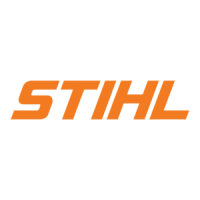BG 56, BG 56 C, BG 66, BG 66 C, BG 86, BG 86 C, SH 56, SH 56 C, SH 86, SH 86 C
English
6
During Operation
Holding and controlling the power
tool
The blower is designed for single-
handed operation with either the right or
left hand on the control handle.
Special care must be taken in slippery
conditions (wet ground, snow) and in
difficult, overgrown terrain. Watch for
hidden obstacles such as tree stumps,
roots and ditches to avoid stumbling. For
better footing, clear away fallen
branches, scrub and cuttings. Be
extremely cautious when working on
slopes or uneven ground.
Working conditions
Operate and start your power tool only
outdoors in a well ventilated area.
Operate it under good visibility and
daylight conditions only. Work carefully.
Warning!
Once the engine has started, immedi-
ately blip the throttle trigger, which
should release the starting throttle and
allow the engine to slow down to idle.
Warning!
This unit is equipped with an ignition
system that is normally in operational
readiness. After the setting lever is
used to stop the engine, it automatically
springs back to the "on" position. If the
engine is warm, it may be possible to
start it by simply pulling the starter rope,
with no further adjustments. To reduce
the risk of injury, be particularly alert to
keep children away from the unit.
Warning!
To reduce the risk of injury from loss of
control, never work on a ladder, in a
tree or any other insecure support.
Never hold the machine above shoul-
der height.
Warning!
As soon as the engine is
running, this product gen-
erates toxic exhaust
fumes containing chemi-
cals, such as unburned
hydrocarbons (including
benzene) and carbon monoxide, that
are known to cause respiratory prob-
lems, cancer, birth defects, or other
reproductive harm. Some of the gases
(e.g. carbon monoxide) may be color-
less and odorless. To reduce the risk of
serious or fatal injury/illness from inhal-
ing toxic fumes, never run the machine
indoors or in poorly ventilated locations:
Warning!
Inhalation of certain dusts, especially
organic dusts such as mold or pollen,
can cause susceptible persons to have
an allergic or asthmatic reaction. Sub-
stantial or repeated inhalation of dust
and other airborne contaminants, in
particular those with a smaller particle
size, may cause respiratory or other ill-
nesses. Control dust at the source
where possible. Use good work prac-
tices, such as operating the unit so that
the wind or operating process directs
any dust raised by the power tool away
from the operator. Follow the recom-
mendations of EPA/OSHA/NIOSH and
occupational and trade associations
with respect to dust ("particulate mat-
ter"). When the inhalation of dust
cannot be substantially controlled, i.e.,
kept at or near the ambient (back-
ground) level, the operator and any
bystanders should wear a respirator
approved by NIOSH/MSHA for the type
of dust encountered.
Warning!
If the substance being blown is a com-
mercial substance, review, understand
and follow all warnings and instructions
contained in the material safety data
sheet for that substance and/or consult
the material manufacturer/supplier. The
state of California and some other
authorities, for instance, have published
lists of substances known to cause can-
cer, reproductive toxicity, etc.

